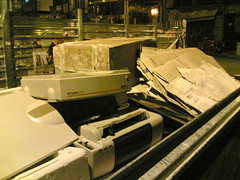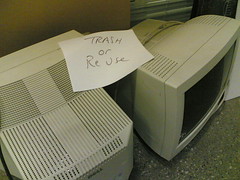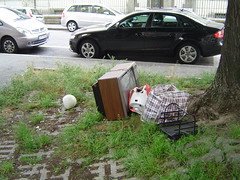Situated Technologies: Toward the Sentient City
Posted: December 9th, 2008 | No Comments »The exhibition Situated Technologies: Toward the Sentient City aims at imagining alternative trajectories for how various mobile, embedded, networked, and distributed forms of media, information and communication systems might inform the architecture of urban space and/or influence our behavior within it. Curated by Mark Shepard and organized by the Architectural League of New York, it will open in September 2009 with 5 commissioned projects that examine the broader social, cultural, environmental and political issues within which the development of urban ubiquitous/pervasive computing is itself situated. One of them, Trash Track, proposed by the MIT SENSEable City Lab (led by Eugenio Morello) will explore how pervasive technologies can help expose the challenges of waste management and sustainability:
Trash Track is inspired by the NYC Green Initiative, which aims to increase the rate of waste recycling in the city to almost 100% by 2030. The project considers how pervasive technologies can help expose the challenges of waste management and sustainability. Trash Track will tag different types of waste and follow these through the city’s waste management system to reveal the end-of-life journey of our everyday objects. Whereas most focus in the economic system is on the supply chain, Trash Track will help underscore the environmental impact of consumer waste by visualizing the waste chain, revealing the ultimate destination of the things we throw away.
In other words, the goal of this project is to reveal the “removal-chain” of our everyday objects and waste with a citizen science approach. This approach raise the concerns of using technologies to solve the very problems they have created, as recently discussed by Anne Galloway in “The Rise of Sensor Citizen“:
For example, projects in this domain rarely, if ever, question the environmental or political impacts of the technologies they seek to employ for environmental and political activism. For example, the United Nations now estimates that almost 50 million tonnes of electronic waste are discarded each year. While the environmental costs of toxic e-waste are substantial and can be added to the environmental impact of manufacturing new electronics, the problem is exacerbated by a variety of related practices that disadvantage developing nations. While all of the projects discussed above advocate using technologies for socially, politically and environmentally positive ends, they also implicitly support existing consumption practices in the developed world, and hide the role that technological progress has played in creating the very problems they seek to improve.
Relation to my thesis: The brainstorm session to develop the Trash Track proposal were an excellent learning experience to understand designers, architects, engineers, urbanists concerns and practices, as well as cultural differences in the approach of people as sensors and urban sustainability. I could not help raising the ambivalence of using dust networks that transforms into e-waste to reduce dust. It will be the fascinating challenge of Track Trash to give a counter example to these concerns. I imagined a scenario that solely focuses on the design of pervasive electronic devices that highlight their own removal-chain and help their recycling.




E-waste removal-chain in contemporary cities

